Motherline: A Self-Portrait Works by Carly McAskill
March 6 – 17, 2013
GALLERY 1313
The key idea of Carly McAskill’s new show, a thesis solo exhibition entitled Motherline: A Self-Portrait, is that identity is built through layers of memory. It is applicable both to individuals and society, the entity that individuals form through their interaction with each other. How so and what materials does the artist use to convey this message? The first is a heavily layered 32′ by 64′ section of old wallpaper on drywall. The artist has used encaustic on it to strip away, tear, and add to the composition, creating new patterns based upon the old. The different layers of material are different perceptual experiences stored and, as the encaustic treatment suggests, constantly subject to revision. Memory does not stand still, like a painting in an art gallery, which makes McAskill‘s work an ironic comment on both memory and art; it is not an object like a ‘still life’ but much more a process, a movement, a flow of sensation that has become temporarily stilled – framed – by discursive parameters.
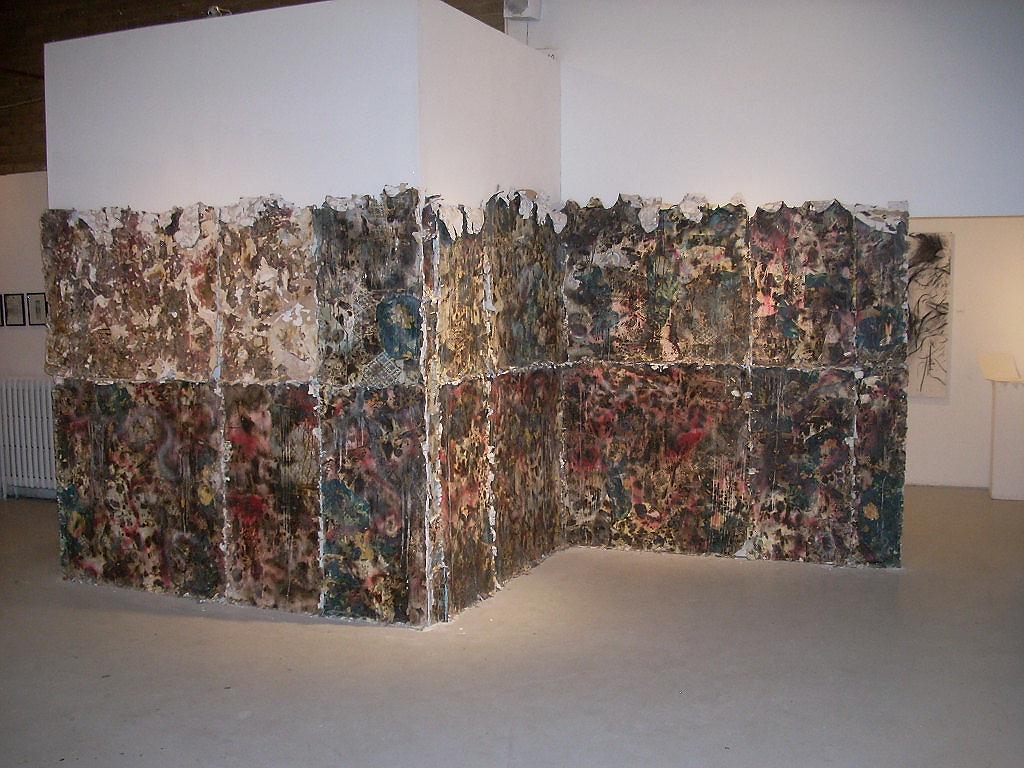 Carly McAskill, If Walls Could Talk, 2012 mixed media on paper
Carly McAskill, If Walls Could Talk, 2012 mixed media on paper
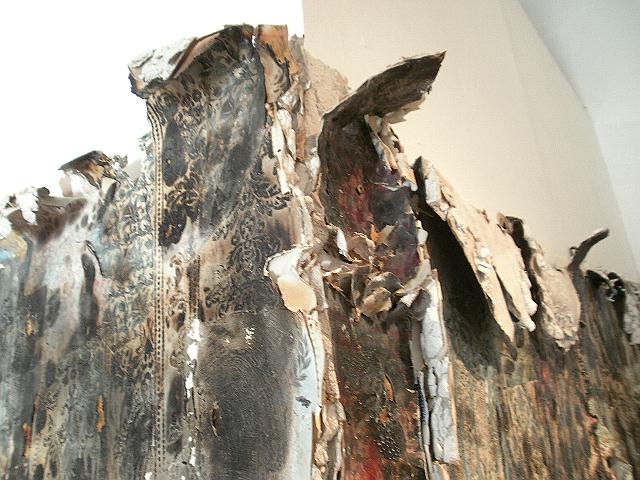 Carly McAskill, If Walls Could Talk, detail, 2012 mixed media on paper
Carly McAskill, If Walls Could Talk, detail, 2012 mixed media on paper
In this instance the discursive parameter is Motherline. A line, and straight lines do not exist in nature, is the human attempt to connect one linear phenomenon to another. It is a function of mechanical causality: B follows A. Daughter follows Mother. As McAskill tell us, things do not follow so neatly. “I feel in constant conflict with keeping my artistic career that I have spent years building up and my yearning to eventually becoming a mother and a wife,” she writes ‘Artist,’ ‘mother’ and ‘wife’ are identities produced through the framing of perceptual based experience, and whose reframing (reprocessing, revision) doesn’t stop until we are no more.
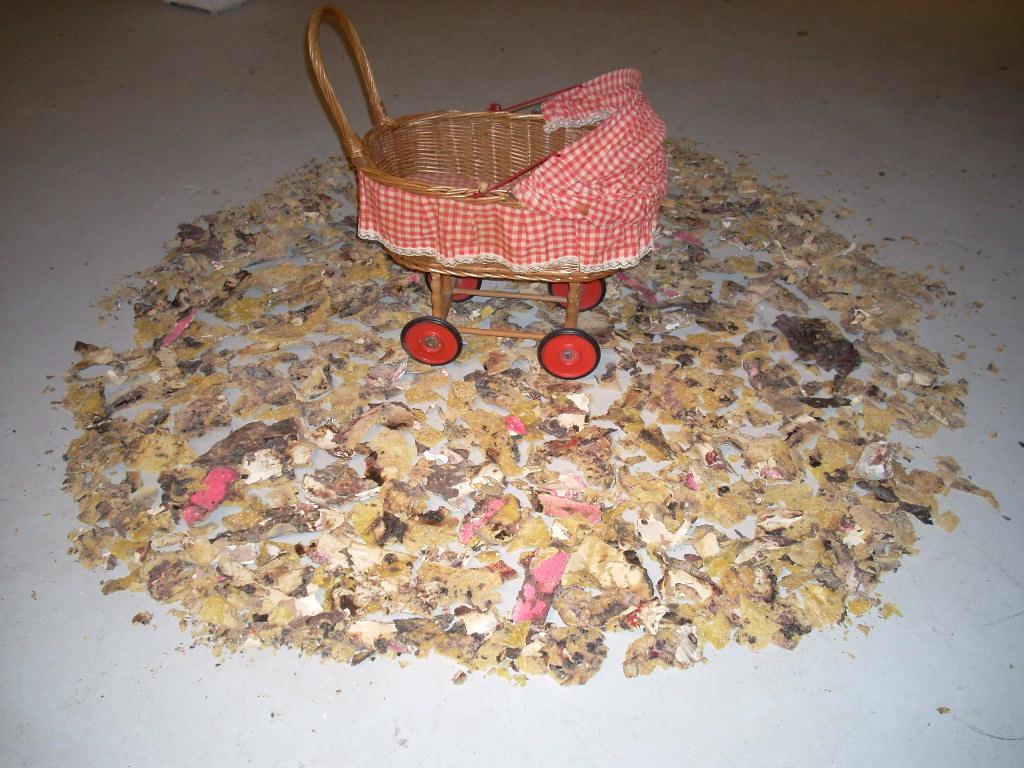 Carly McAskill, If Walls Could Talk, 2012 mixed media on paper
Carly McAskill, If Walls Could Talk, 2012 mixed media on paper
There is a red striped toy baby carriage surrounded by pieces of drywall and encaustic signifying, as I take it, childhood. Is that how memory works, images encircled by debris, by the detritus of things that once were? As if, somehow, the image is the survivor of a vast swathe of perceptual destruction, standing proudly, even defiantly out of otherwise nothingness?
On one wall *A Self-Portrait*, Flamboyant is extravagant, it is at once mystical, whimsy, mythical and powerful. Swirling in dark purple coils on the outside with curvilinear areas of bright green-blue on the inside, the figure with the artist’s recognizable face wears a crown of hairpins with dark purple on one side and yellow and pink stripes on the other. What is the relationship of self to memory? How do we recognize ourselves? Lacan spoke of a misunderstanding by which a body takes itself to be an image. If so, it is a most fruitful error.
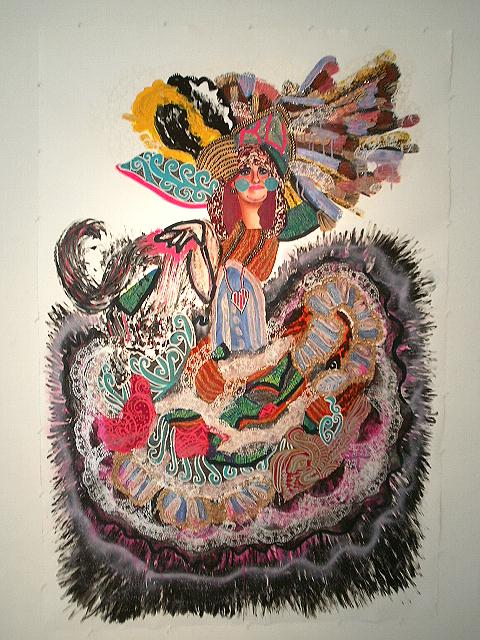 Carly McAskill, A Self Portrait, 2012, mixed media on paper, 74 x 50 inches
Carly McAskill, A Self Portrait, 2012, mixed media on paper, 74 x 50 inches
Is self an image or is only conceivable in terms of one, and that the ‘real’ self may not exist? Once captured as an image, it becomes lost. Is self-image then a delusion? Does an artist continually recreate the self through a work in a game of lost and found, hide and seek? What do we see when we peer through the layered constructs of an identity if not its spaces?
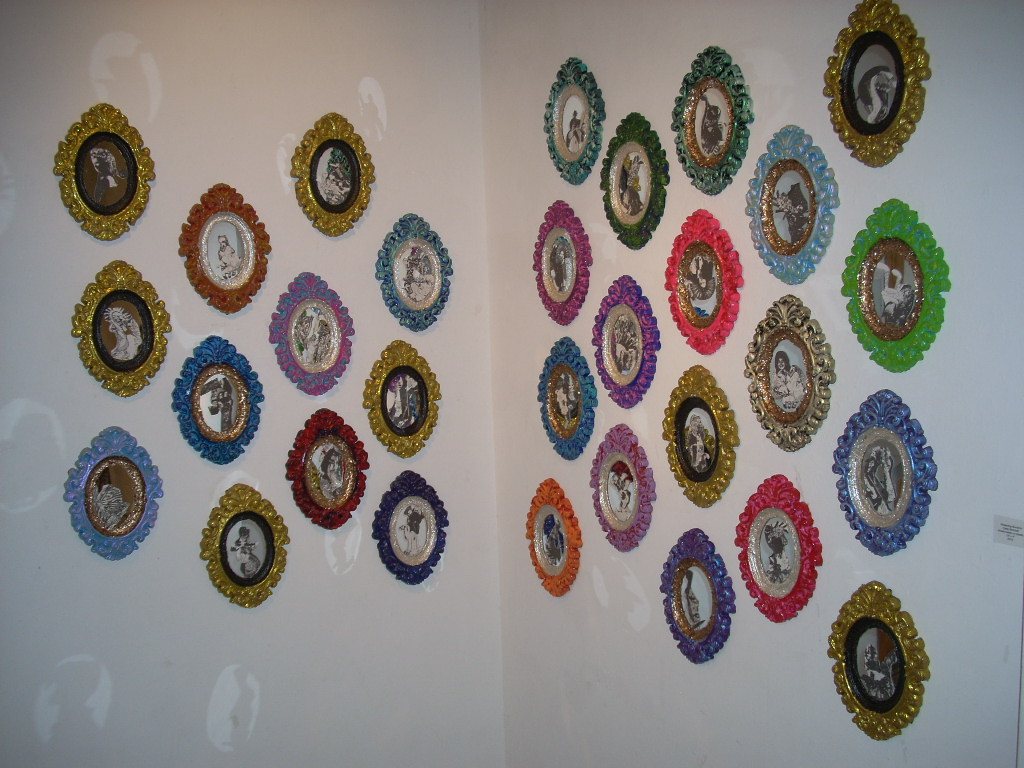 Carly McAskill, Reflecting Burdens, 2012, mixed media on plastic
Carly McAskill, Reflecting Burdens, 2012, mixed media on plastic
In a corner, McAskill has arranged 30 small mirrors with fancy, ornate frames, each having a variety of images, some of machines, others of natural scenes, while anothers with her childhood face. The mirror image suggests reflection, how it is that we see ourselves. What is the glass? Is it no tart itself? Is art the glass through which we capture what we think we are; how we remember ourselves to be? If so, then to think is to remember or thought is unthinkable without it. Memory is the mind again, and in ancient Greek myth, the Mother of the Muses, the patronesses of all arts and sciences, and whose name is the root of the word music, is *Mnemosyne*, Memory personified. Is this the Motherline of Memory? If mother, then father. Who coupled with Memory to produce art and science? It was Zeus, the exemplar of logic, his name derived from the Greek *zeugein*, to yoke, join as in the word zygote. Motherline has, in other words, some logic to it which joins or yokes the images.
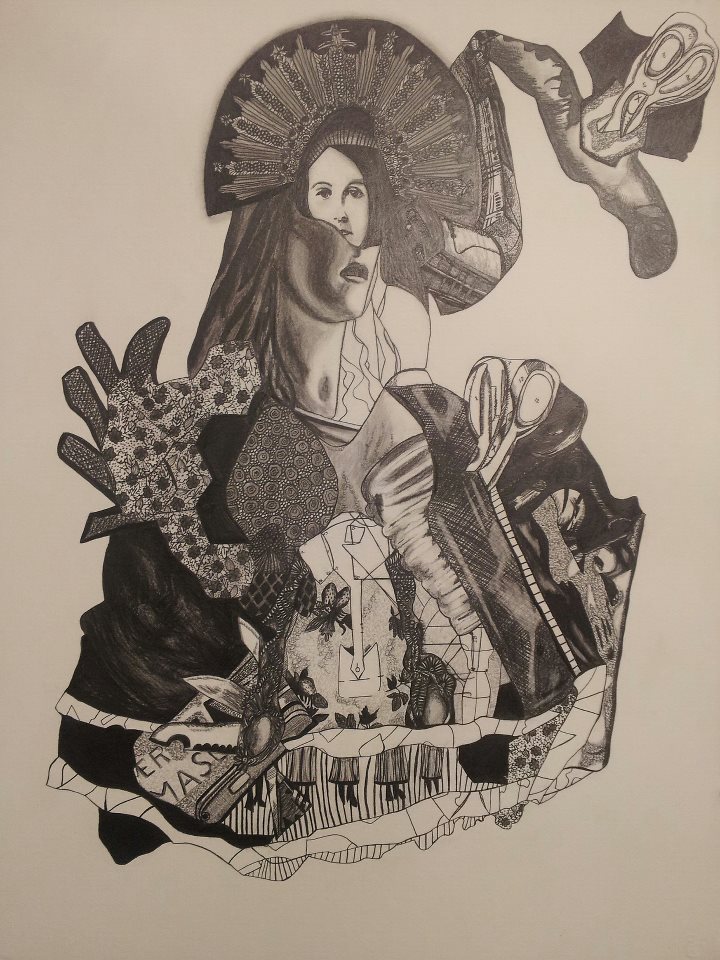 Carly McAskill, Florence Desjardins, 2012, pencil on paper, 30 x 23 iches
Carly McAskill, Florence Desjardins, 2012, pencil on paper, 30 x 23 iches
On another wall facing *A Self Portrait* are six graphite paper drawings of McAskill‘s family tree with her grandmother, mother and sister’s faces. There is also one male image, that, I assume, of George V, the late father of the present queen, and Commonwealth sovereign of her grandmother’s era. Is the mind of memory the art of reflection? Is the logic of a life the continual struggle to remember who and what it is? Are the discursive parameters framing the act of recollection the doing of art?
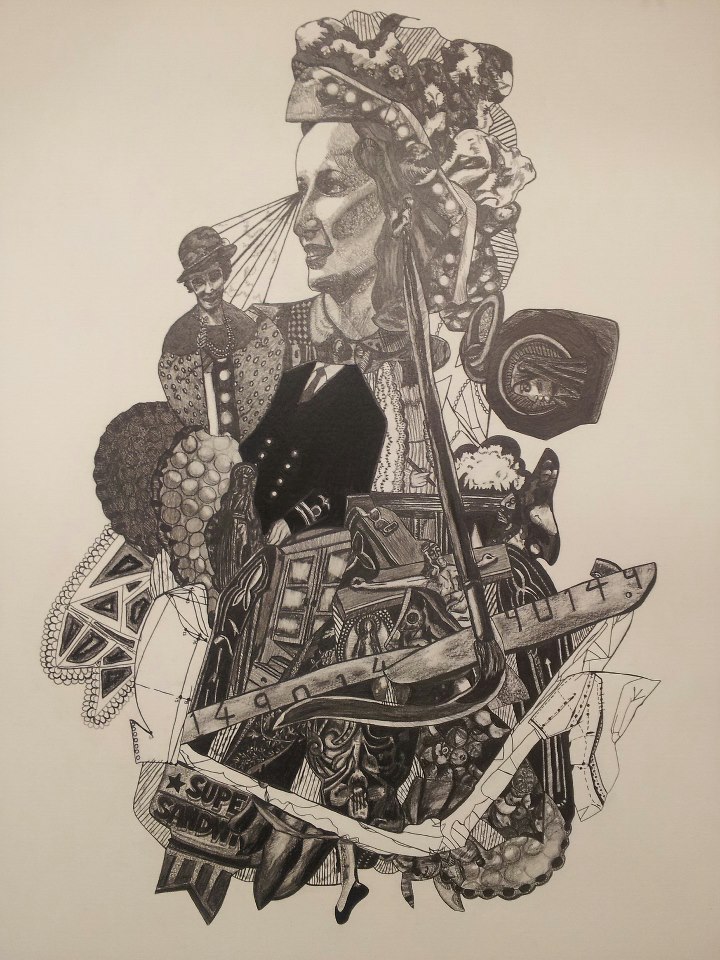 Carly McAskill, Anne Baldasero, 2012, pencil on paper, 30 x 23 inches
Carly McAskill, Anne Baldasero, 2012, pencil on paper, 30 x 23 inches
McAskill‘s current exhibition raises these questions and more. Her own mnemonic Odyssey into herself can help launch similar projects in us all.
David A. Ross
Photo: Phil Anderson

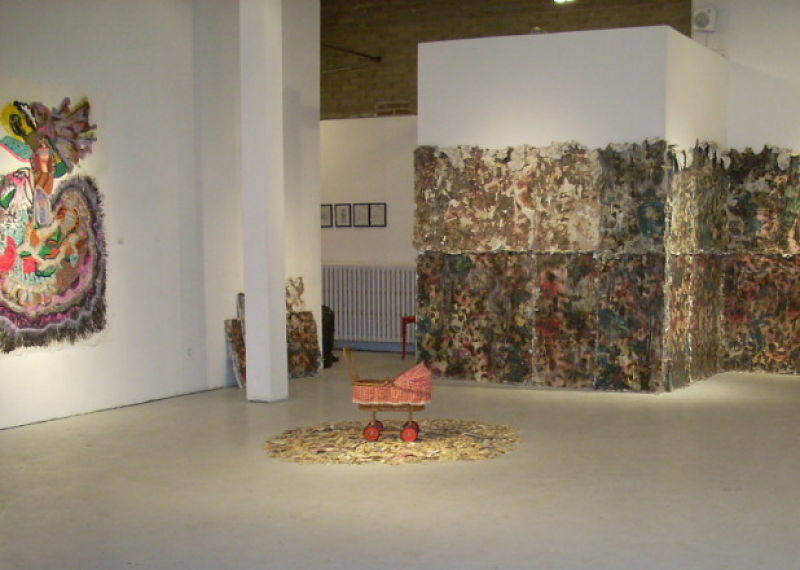
Nice work Carly. Proud of you.